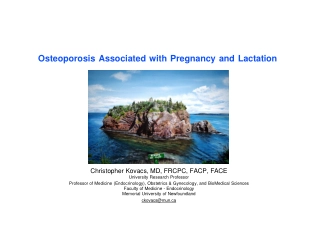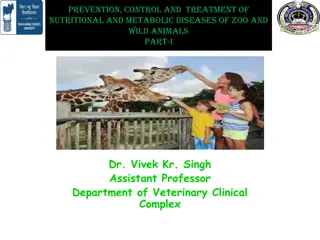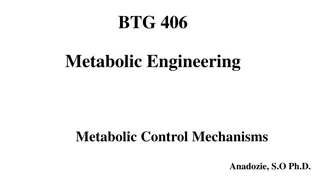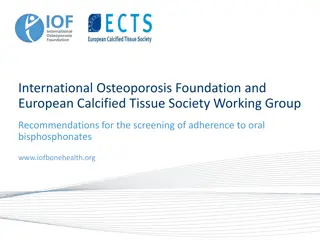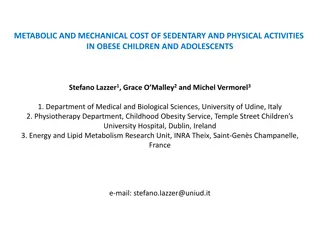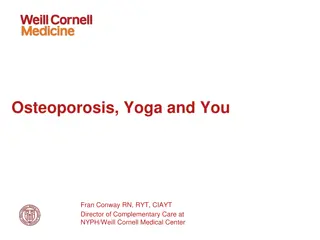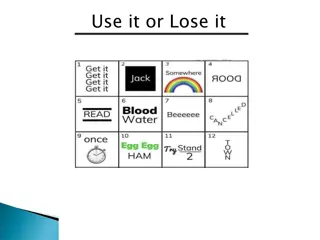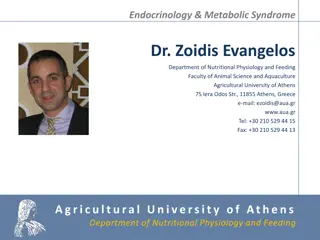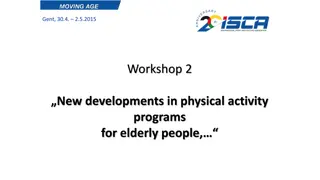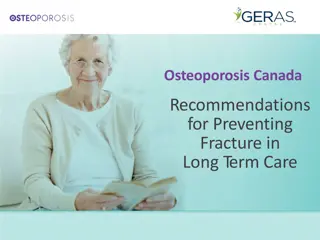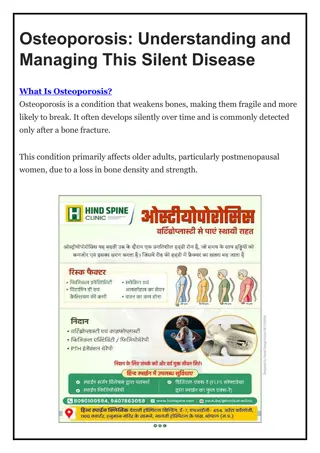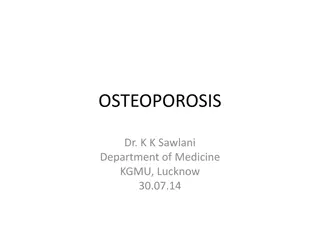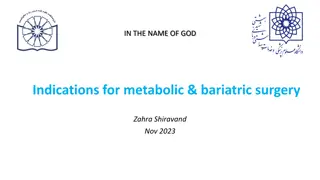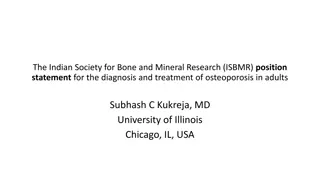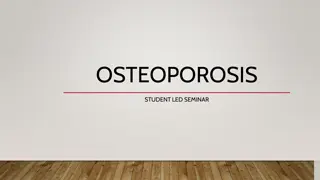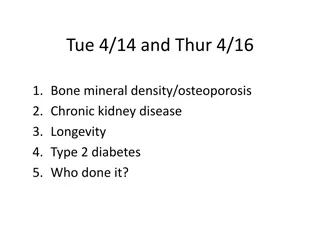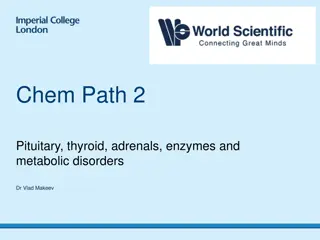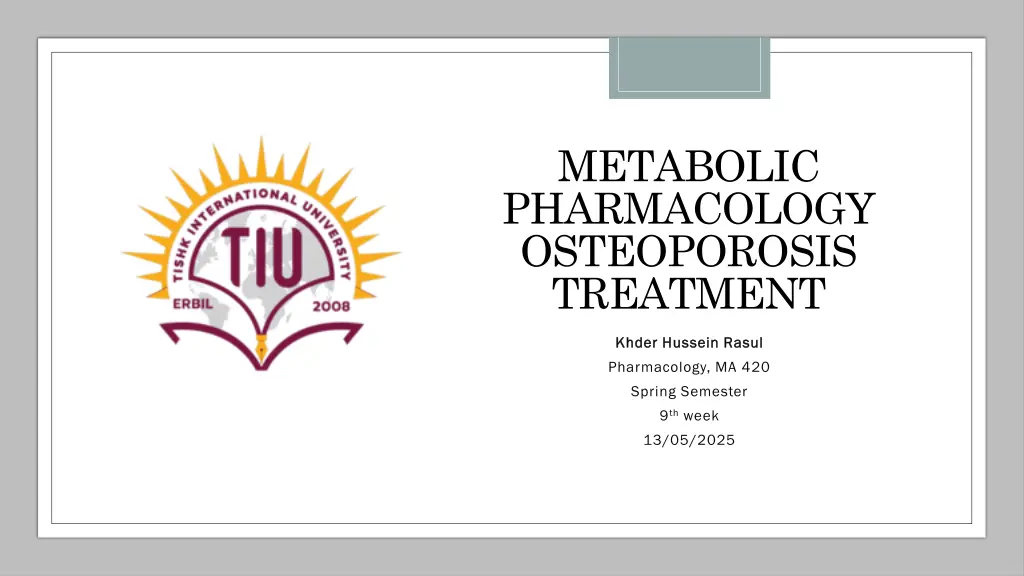
Understanding Osteoporosis: Causes, Effects, and Treatment
Osteoporosis is a chronic metabolic bone disease characterized by decreased bone mass, leading to increased fragility and fracture risk. Learn about the bone remodeling process, commonly affected bones, and causes like aging, hormonal changes, and nutrient deficiencies. Discover how osteoporosis impacts bone structure and the drugs used in prevention and treatment.
Download Presentation

Please find below an Image/Link to download the presentation.
The content on the website is provided AS IS for your information and personal use only. It may not be sold, licensed, or shared on other websites without obtaining consent from the author. If you encounter any issues during the download, it is possible that the publisher has removed the file from their server.
You are allowed to download the files provided on this website for personal or commercial use, subject to the condition that they are used lawfully. All files are the property of their respective owners.
The content on the website is provided AS IS for your information and personal use only. It may not be sold, licensed, or shared on other websites without obtaining consent from the author.
E N D
Presentation Transcript
METABOLIC PHARMACOLOGY OSTEOPOROSIS TREATMENT Khder Hussein Rasul Khder Hussein Rasul Pharmacology, MA 420 Spring Semester 9thweek 13/05/2025
Outline Osteoporosis 2 Khder Hussein Rasul 06/06/2025
Objectives By the end of this lecture, students should be able to: Understand osteoporosis. 1. 2. Being familiar with bones affected by osteoporosis. 3. Learn about causes of osteoporosis 4. Understand the bone remodeling. 5. Learn about drugs used in the prevention and treatment of osteoporosis 3 Khder Hussein Rasul 06/06/2025
Bone Bone is a special connective tissue that 1. Provides structural support 2. Facilitates movement 3. Protects vital organs. 06/06/2025 Khder Hussein Rasul 4
Bone Bone contains 1. Osteoblasts 2. Osteocytes 3. Osteoclasts or bone resorbing cells 4. Organic components 5. Inorganic components 6. Nerves 7. blood vessels 06/06/2025 Khder Hussein Rasul 5
Osteoporosis Osteoporosis is a chronic metabolic bone disease characterized by decreased bone mass and deterioration of bone microarchitecture, leading to 1. Increased bone fragility 2. Increased risk of fractures. 06/06/2025 Khder Hussein Rasul 6
Osteoporosis Bone is a living tissue, connective tissue, constantly undergoing remodeling through two types of cells 1. Osteoclasts: break down old bone (resorption) 2. Osteoblasts: build new bone (formation) In osteoporosis Bone resorption becomes greater than bone formation. Bones become thinner, weaker, and more porous 06/06/2025 Khder Hussein Rasul 7
Bones commonly affected by osteoporosis Osteoporosis can affect any bone in the body, but it most commonly affects bones that have a high content of trabecular (spongy) bone, because this type of bone is more metabolically active and turns over faster than compact (cortical) bone. Common sites 1. Hip 2. Spine 3. Wrist 06/06/2025 Khder Hussein Rasul 8
Causes of osteoporosis 1. Aging (especially postmenopausal women) 2. Hormonal changes (decrease estrogen) 3. Vitamin D deficiency 4. Calcium deficiency 5. Lifestyle factors: Sedentary behavior, smoking, alcohol 06/06/2025 Khder Hussein Rasul 9
Bone remodeling Bone is constantly remodeled: resorption (osteoclasts) and formation (osteoblasts) In osteoporosis: resorption > formation 06/06/2025 Khder Hussein Rasul 10
Drugs used in the prevention and treatment of osteoporosis Drugs may be used to 1. Prevent bone resorption 2. Promote bone formation 3. Combination of both in the prevention and treatment of osteoporosis. These drugs reduce the risk of fractures in patients with osteoporosis. 06/06/2025 Khder Hussein Rasul 11
Drugs that prevent bone resorption (Anti-resorptive drugs) 1. Calcium (increases bone minerals density) 2. Vitamin D (increase absorption of calcium) 3. Calcitonin (prevents bone resorption, increases bone minerals density) 4. Estrogens (prevents osteoporosis) 5. Raloxifene: selective estrogen receptor 6. Bisphosphonates (decrease bone resorption, increases bone minerals density) These drugs slow down bone resorption by inhibiting osteoclast activity. 06/06/2025 Khder Hussein Rasul 12
Drugs that prevent bone resorption (Anti-resorptive drugs) Raloxifene (Selective estrogen receptor modulators) Acts like estrogen on bones (protective) Used in postmenopausal women Side effect: Risk of blood clots 06/06/2025 Khder Hussein Rasul 13
Drugs that prevent bone resorption (Anti-resorptive drugs) Bisphosphonates (decrease bone resorption, increases bone minerals density) Examples: Alendronate, Risedronate, Zoledronate Mechanism: Bind to bone to inhibit osteoclasts, then decrease bone breakdown Side effects: GI upset and esophageal irritation 06/06/2025 Khder Hussein Rasul 14
Drugs that promote bone formation 1. Fluoride: it causes increase osteoblastic activity, then increase bone mass. 2. Testosterone (in hypogonadal men) 3. Anabolic steroids (in postmenopausal women) 4. PTH analogs. These drugs stimulate bone formation. 06/06/2025 Khder Hussein Rasul 15
Drugs that promote bone formation PTH analogs Example: Teriparatide (PTH analog) Recombinant form of parathyroid hormone, it causes increase osteoblasts, then build bone Side effects: nausea, dizziness 06/06/2025 Khder Hussein Rasul 16

